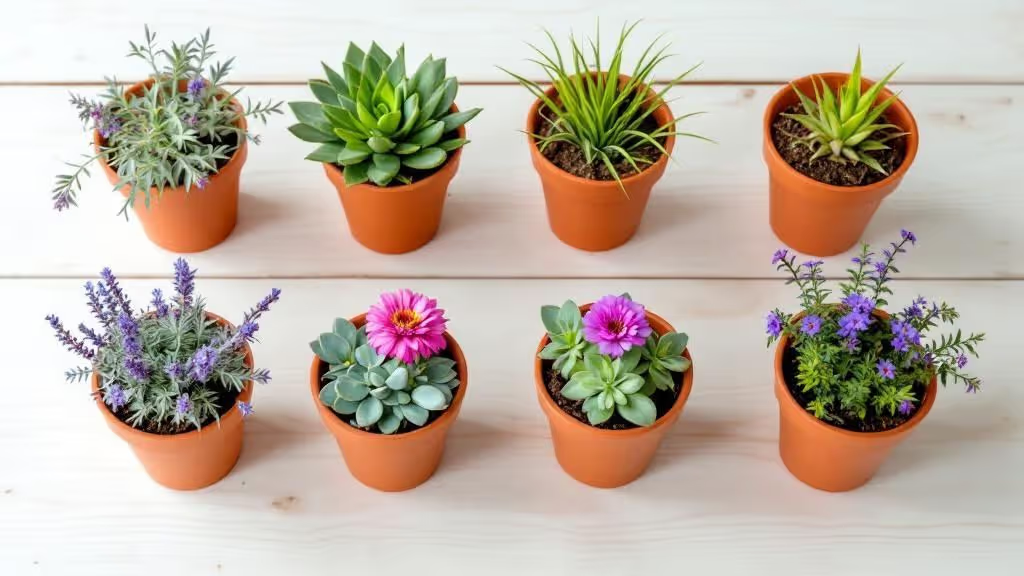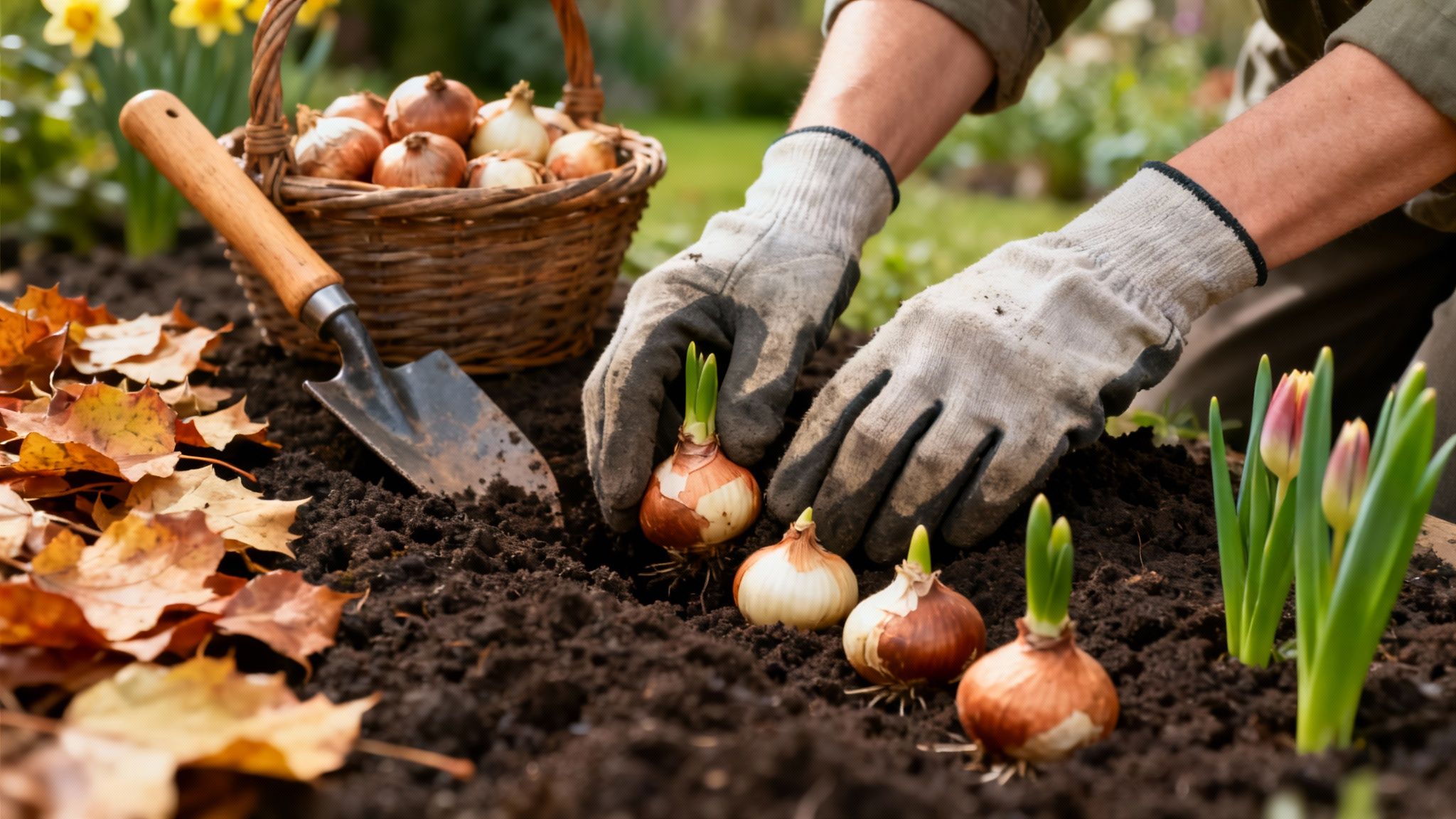As UK summers become hotter and drier, creating a garden that thrives with less water is no longer a niche concept. It's an essential strategy for maintaining beautiful, sustainable outdoor spaces. The shift towards a more resilient planting approach doesn't mean sacrificing colour, texture, or the wildlife that brings your garden to life. In fact, embracing a water-wise ethos opens up a world of stunning, low-maintenance options perfectly suited to our changing climate.
This guide moves beyond generic advice to provide a practical, curated selection of the best drought tolerant plants UK gardeners can rely on. We will explore eight of the most robust and attractive species, detailing not just what to plant, but precisely how to ensure they establish and flourish for long-term success. You'll learn the specific soil conditions, planting techniques, and minimal care required to build a garden that remains a vibrant sanctuary, even when the rain stays away.
Prepare to discover how to transform your garden into a beautiful, water-wise haven that conserves resources while looking spectacular. This list provides the actionable steps needed to create a resilient landscape that flourishes year after year with minimal intervention.
1. Lavandula angustifolia (English Lavender)
No list of drought tolerant plants in the UK would be complete without the iconic Lavandula angustifolia, or English Lavender. Despite its name, this hardy perennial originates from the sun-drenched, rocky slopes of the Mediterranean. This heritage is the key to its resilience; it has evolved to thrive in dry, free-draining conditions, making it perfectly suited to the UK’s increasingly common summer heatwaves and periods of low rainfall. Its silvery-green foliage is specially adapted to conserve moisture, while its fragrant, purple flower spikes provide a valuable nectar source for bees and butterflies, supporting local biodiversity.
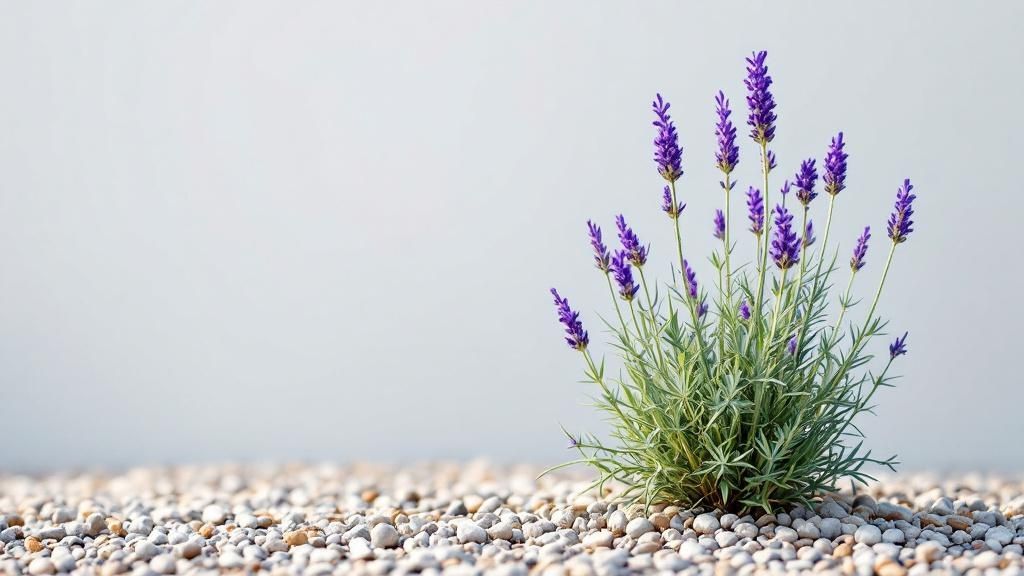
Once established, English Lavender requires minimal watering, making it a sustainable and low-maintenance choice for almost any garden style, from cottage borders to contemporary gravel gardens. Its year-round structure and aromatic presence have made it a favourite of gardening experts like Monty Don and Sarah Raven.
Key Characteristics & Planting Tips
- Sunlight: Thrives in full sun. At least six hours of direct sunlight per day is ideal for prolific flowering and intense fragrance.
- Soil: Requires very well-drained soil. If you have heavy clay, improve drainage by incorporating grit or planting on a mound or slope. Lavender detests having "wet feet," especially in winter.
- Pruning: The most crucial care step is pruning. Cut back hard after flowering, typically in late August, but be careful not to cut into old, bare wood. This maintains a compact, bushy shape and prevents the plant from becoming woody and leggy.
- Watering: Water regularly during its first year to establish a strong root system. Afterwards, it is remarkably drought-tolerant. Water deeply but infrequently during prolonged dry spells.
Expert Insight: For the most potent fragrance, harvest lavender stems just as the first few flowers on the spike have opened. This is when the essential oils are at their peak. Hang them in bunches to dry for use in home fragrance or culinary creations.
2. Sedum spectabile (Ice Plant/Stonecrop)
An essential addition to any list of drought tolerant plants in the UK is the robust and reliable Sedum spectabile, commonly known as the Ice Plant or Stonecrop. This succulent perennial is a masterpiece of natural engineering, storing water within its thick, fleshy leaves. This adaptation allows it to withstand prolonged dry spells and challenging conditions with minimal fuss, making it a star performer in sun-baked borders and gravel gardens. Its architectural form provides interest from spring, culminating in spectacular flat-topped clusters of pink or white flowers in late summer and autumn. These blooms are a critical late-season nectar source, attracting bees and butterflies when other flowers have faded.
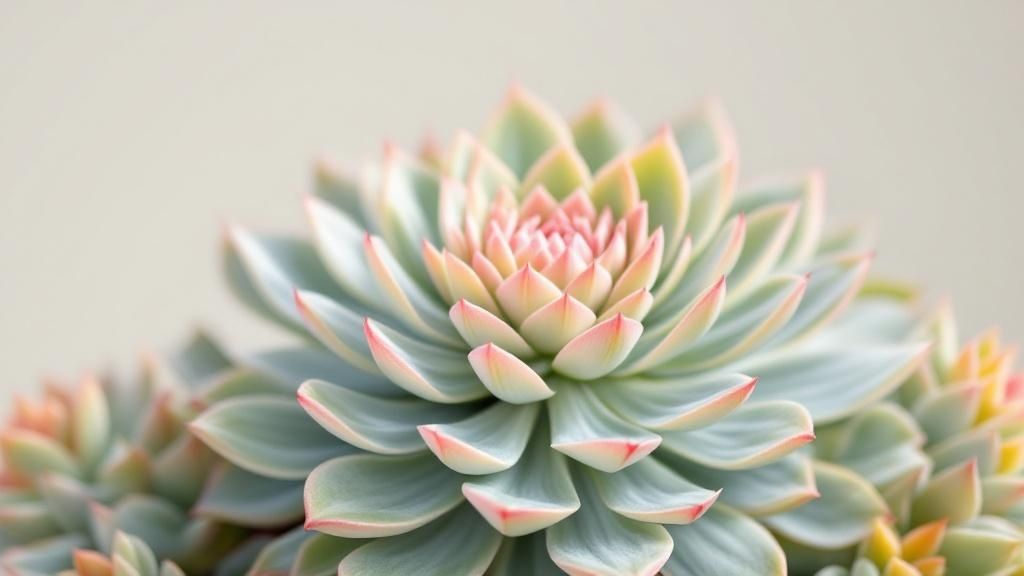
Once established, its needs are few, flourishing even in poor soil. The appeal of sedums has been championed by leading garden designers like Piet Oudolf, who uses them extensively in his naturalistic planting schemes, and the late Beth Chatto, a pioneer of drought-tolerant gardening. Its structural beauty is showcased in iconic gardens like RHS Hyde Hall's Dry Garden, proving its value for both aesthetic appeal and water-wise gardening.
Key Characteristics & Planting Tips
- Sunlight: Demands full sun to maintain a sturdy, upright habit and produce abundant flowers. In shadier spots, stems can become long and floppy.
- Soil: Thrives in poor to average, well-drained soil. Rich, fertile soil can lead to weak, leggy growth that is prone to splitting open. It is an ideal plant for shallow, chalky, or sandy soils.
- Pruning: Leave the flower heads on the plant over winter. They provide crucial architectural interest and a food source for birds. Cut the old stems back to the ground in early spring, just as new growth emerges from the base.
- Watering: Water only during its first season to help it establish. Mature plants are exceptionally drought-resistant and rarely need supplemental watering, even during UK heatwaves.
Expert Insight: To prevent taller varieties from flopping, perform the 'Chelsea Chop'. In late May, cut the entire plant back by about a third. This delays flowering slightly but results in a more compact, sturdier plant with more, albeit smaller, flower heads.
3. Rosmarinus officinalis (Rosemary)
An essential addition to any UK garden designed to withstand dry spells is the wonderfully aromatic Rosmarinus officinalis, or Rosemary. This woody evergreen herb is a native of the sun-baked, rocky coastlines of the Mediterranean, which has equipped it with superb drought-resistant qualities. Its distinctive needle-like leaves are ingeniously designed with a waxy coating and tiny hairs that minimise water loss through transpiration, while its deep, robust root system can seek out moisture far below the soil surface, making it one of the most reliable drought tolerant plants UK gardeners can choose.
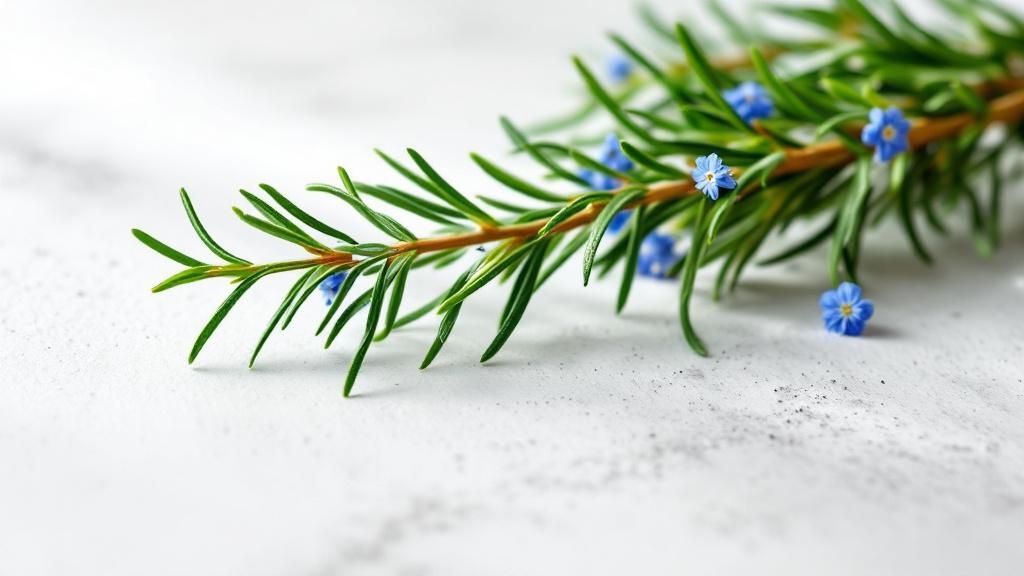
Once it has settled in, Rosemary is exceptionally low-maintenance and provides fantastic year-round structure and colour. Its culinary versatility is celebrated by chefs like Jamie Oliver, while its early spring flowers are a lifeline for emerging bees. Its presence in prestigious gardens, such as the Mediterranean displays at RHS Wisley, confirms its status as a top-performing, water-wise plant.
Key Characteristics & Planting Tips
- Sunlight: Demands a position in full, direct sun. A south-facing wall is the ideal location, as it provides maximum sunlight and reflected heat.
- Soil: Excellent drainage is non-negotiable. Rosemary thrives in poor, sandy or chalky soils and will struggle in heavy, waterlogged clay. Amend clay soils with generous amounts of horticultural grit.
- Pruning: To prevent the plant from becoming woody and sparse, prune lightly immediately after it has finished flowering. Regular harvesting of the tips for culinary use also encourages bushier, more compact growth.
- Watering: Water consistently in its first growing season to help it establish. Mature plants are extremely drought-tolerant and will rarely need watering, except during the most severe and prolonged droughts.
Expert Insight: For gardeners in colder or more exposed parts of the UK, choose a particularly hardy cultivar like 'Miss Jessopp's Upright'. Planting it against a house wall not only provides shelter from harsh winds but also offers crucial winter protection.
4. Echinacea purpurea (Purple Coneflower)
A stunning prairie native from North America, Echinacea purpurea has rightfully earned its place as a cornerstone of the modern UK garden. Commonly known as the Purple Coneflower, this hardy perennial is celebrated for its distinctive, daisy-like petals that sweep back from a prominent, spiky central cone. This architectural form provides brilliant summer and autumn colour. Its resilience is rooted in a deep taproot system, which allows it to delve far into the soil to find moisture, making it an excellent choice for gardens facing dry spells. Its sturdy nature ensures it performs reliably even in challenging conditions.
Once established, Echinacea is one of the best drought tolerant plants UK gardeners can choose for adding height and long-lasting structure to a border. Its value has been championed by influential designers like Piet Oudolf, who uses it extensively in his naturalistic plantings. You can see it thriving in the dry gardens at RHS Garden Hyde Hall and in many National Trust properties, proving its suitability for a changing British climate.
Key Characteristics & Planting Tips
- Sunlight: Demands a position in full sun to produce a profusion of strong, vibrant flowers.
- Soil: Prefers well-drained soil but is more tolerant of clay than Mediterranean plants like Lavender. Good drainage, however, is key to prevent winter rot.
- Care: Deadhead spent blooms regularly to encourage a continuous display of flowers. To support wildlife, leave some of the last seed heads standing over winter; they provide a valuable food source for goldfinches and add structural interest to the frosty garden.
- Planting: Plant in spring to give it a full growing season to establish its deep root system before winter. Combine it with ornamental grasses such as Stipa or Calamagrostis for a beautiful, low-maintenance, prairie-style effect.
Expert Insight: To keep your plants vigorous and floriferous, it's a good practice to divide the clumps every three to four years in the spring. This rejuvenates the parent plant and provides you with new plants to expand your display or share with fellow gardeners.
5. Achillea millefolium (Yarrow)
For a plant that truly embodies resilience and natural charm, look no further than Achillea millefolium, commonly known as Yarrow. This hardy perennial is a UK native, which explains its exceptional ability to handle our unpredictable climate. Yarrow's toughness comes from its deeply divided, feathery foliage, which minimises water loss, and an extensive root system that seeks out moisture deep within the soil. It’s a classic cottage garden staple that offers more than just good looks; its flat-topped flower clusters are a magnet for bees, hoverflies, and butterflies.
While the native species is beautiful, modern cultivars provide a stunning palette of colours from soft pastels to vibrant yellows and reds, all while retaining their legendary toughness. This makes Yarrow one of the most versatile drought tolerant plants in the UK, equally at home in a manicured border at Sissinghurst Castle Garden or a wildflower meadow project. Legendary gardeners like Beth Chatto famously incorporated it into her pioneering dry garden experiments.
Key Characteristics & Planting Tips
- Sunlight: Demands full sun to produce sturdy stems and abundant flowers. In shadier spots, it can become tall and floppy.
- Soil: Extremely adaptable and will tolerate poor, dry soils where other plants fail. It thrives in well-drained conditions and dislikes heavy, waterlogged clay.
- Pruning: Cut back spent flower stalks to the base to encourage a second flush of blooms. To prevent it from becoming too invasive, it's wise to cut the entire plant back to ground level in late autumn.
- Watering: Once its root system is established after the first year, Yarrow is incredibly self-sufficient and rarely needs supplementary watering, even during extended dry periods.
- Division: To maintain vigour and control its spread, divide clumps every two to three years in the spring.
Expert Insight: Yarrow is a fantastic companion plant. Its umbel-shaped flowers attract beneficial insects like ladybirds and lacewings, which act as natural pest control for nearby plants like roses and vegetables. Plant it strategically to boost your garden's overall health.
6. Santolina chamaecyparissus (Cotton Lavender)
For a splash of silver texture, Santolina chamaecyparissus, or Cotton Lavender, is an exceptional choice among drought tolerant plants for UK gardens. This compact, evergreen shrub hails from the Mediterranean region, bringing its inherent resilience to our shores. Its finely divided, woolly, aromatic foliage is a masterclass in water conservation, giving it a distinctive silvery-grey appearance that shines in the sun. Despite its name, it is not a true lavender but shares its love for sun and dry conditions. Its dense, mounding habit makes it superb for creating structure, whether used as formal edging, in historic knot gardens, or as a textural ground cover in a gravel garden.
Once established, Cotton Lavender is brilliantly self-sufficient, requiring very little water. Its year-round presence provides constant interest and it is favoured by garden designers like Penelope Hobhouse and Dan Pearson for its ability to provide strong lines and textural contrast. Its use in the formal gardens at Levens Hall and in Mediterranean-style plantings at RHS Garden Rosemoor highlights its versatility.
Key Characteristics & Planting Tips
- Sunlight: Demands a position in full sun to maintain its tight shape and vibrant silver colour.
- Soil: Excellent drainage is non-negotiable. It thrives in poor, sandy, or gritty soil and will struggle in heavy, wet clay, especially during winter. Amend soil with horticultural grit to improve its structure.
- Pruning: Pruning is vital to prevent the plant from becoming woody and splitting open. Trim it back hard after it has finished flowering in late summer, or in early spring if you prefer. For formal low hedges, clip regularly throughout the growing season.
- Watering: Water new plants until they are established. Mature plants are extremely drought-resistant and will rarely need supplementary watering, except in the most severe and prolonged droughts.
Expert Insight: If you are growing Santolina primarily for its stunning silver foliage, you can clip off the bright yellow, button-like flower heads as they appear. This directs all the plant's energy into producing its beautiful, aromatic leaves, creating a more uniform and impactful silver mound.
7. Verbena bonariensis (Purple Top)
A staple of modern garden design, Verbena bonariensis has earned its place as one of the most elegant and reliable drought tolerant plants in the UK. Hailing from South America, this tall, architectural perennial is celebrated for its unique structure. It produces wiry, see-through stems topped with clusters of vibrant purple flowers, creating an ethereal, airy effect. This transparency allows it to be placed anywhere in a border, even the front, without obscuring the plants behind it, providing height and late-season colour from summer through to the first frosts.

Its ability to thrive in full sun and well-drained soil makes it a perfect candidate for gravel gardens and dry borders. Once established, it requires very little water and provides a crucial food source for pollinators late in the year. Its widespread use in the naturalistic planting schemes of designers like Piet Oudolf and Sarah Price is a testament to its beauty, resilience, and ecological value, making it an indispensable plant for a sustainable, modern UK garden.
Key Characteristics & Planting Tips
- Sunlight: Demands full sun to perform well and remain upright. A lack of sun can cause the stems to become weak and floppy.
- Soil: Prefers poor to moderately fertile, well-drained soil. It is perfectly happy in dry conditions and does not require rich compost or feeding.
- Pruning: Leave the structural seed heads over winter. Cut the old stems back to the base in late spring, once you see new growth emerging. This protects the crown from winter cold and wet.
- Watering: Water during its first season to get established. Mature plants are extremely drought-tolerant and will rarely need supplementary watering, except in the most severe and prolonged droughts.
Expert Insight: Verbena bonariensis is a prolific self-seeder. To maintain a naturalistic drift, allow some seedlings to mature where they appear. In colder parts of the UK where it may not survive winter, treat it as an annual and simply allow the self-sown seeds to provide next year’s display.
8. Stipa tenuissima (Mexican Feather Grass)
For adding movement and a soft, ethereal texture to a garden, few plants can rival Stipa tenuissima, commonly known as Mexican Feather Grass. This ornamental grass epitomises the beauty of low-maintenance, drought-tolerant planting. Its incredibly fine, thread-like leaves form a soft, upright clump, topped with feathery, pale green flower panicles that mature to a beautiful blonde hue. These plumes dance and sway in the slightest breeze, creating a mesmerising, shimmering effect that brings a dynamic quality to planting schemes. This ability to thrive in dry conditions makes it an exceptional choice for gravel gardens and sun-baked borders in the UK.
Once established, Stipa tenuissima is one of the most resilient and water-wise drought tolerant plants UK gardeners can choose. It provides invaluable year-round structure and texture with minimal fuss. Its widespread use by influential designers like Tom Stuart-Smith and Dan Pearson in their naturalistic compositions has cemented its place as a modern garden staple. You can see its graceful form used to great effect in showcase gardens, such as the Dry Garden at RHS Garden Hyde Hall.
Key Characteristics & Planting Tips
- Sunlight: Demands full sun to maintain its shape and produce the best feathery flowerheads. In shade, it can become floppy and less impactful.
- Soil: Excellent drainage is non-negotiable. It thrives in poor, sandy, or gravelly soils and will struggle in heavy, wet clay, especially over winter.
- Pruning: Unlike many other ornamental grasses, it should not be cut back hard. Instead, simply "comb" through the plant with your gloved fingers in late winter or early spring to remove any dead, straw-like foliage and tidy its appearance.
- Planting: For the most dramatic visual impact, plant Stipa tenuissima in large drifts or swathes rather than as single specimens. This creates the signature flowing, cloud-like effect seen in professional garden designs. It self-seeds readily, so be prepared to remove unwanted seedlings to control its spread.
Expert Insight: Pair Stipa tenuissima with bold, structural perennials like Verbena bonariensis or colourful, mounding plants like Sedum 'Herbstfreude'. The grass's fine texture provides a perfect softening counterpoint to the more defined shapes, creating a balanced and visually interesting display.
Drought Tolerance Comparison of 8 UK Plants
Cultivating a Resilient and Beautiful Garden
Creating a garden that can withstand the increasingly dry summers in the UK is no longer a niche pursuit; it's a smart, sustainable, and ultimately rewarding strategy. Throughout this guide, we have explored a fantastic selection of plants that prove you don't need to sacrifice beauty for resilience. From the silvery foliage and calming scent of Lavandula angustifolia (English Lavender) to the statuesque, airy wands of Verbena bonariensis, each plant offers a unique combination of texture, colour, and form.
The key takeaway is that a thriving, low-water garden is about more than just individual plant choices. It’s about cultivating a holistic ecosystem. The plants we’ve detailed, including the steadfast Rosmarinus officinalis (Rosemary), the vibrant Echinacea purpurea (Purple Coneflower), and the tough-as-nails Achillea millefolium (Yarrow), all share common traits. They often feature silvery or hairy leaves to reduce moisture loss and deep taproots to seek out water far below the surface. Understanding these adaptations is the first step toward building a truly self-sufficient garden.
Your Action Plan for a Water-Wise Garden
To translate this inspiration into action, consider these practical next steps. Your journey towards a stunning, low-maintenance garden begins now.
- Assess and Amend Your Soil: Before you even think about buying plants, get your hands dirty. Check your soil's drainage by digging a hole and filling it with water. If it takes hours to drain, incorporate generous amounts of horticultural grit and organic matter like well-rotted compost. This one-time effort is the single most important investment you can make for success with drought tolerant plants UK.
- Start Small and Group Plants: Don't feel pressured to overhaul your entire garden at once. Begin with a single, challenging sunny spot, perhaps a border against a south-facing wall or a container on a patio. Group plants with similar water needs together, a practice known as hydrozoning. This makes watering more efficient and ensures every plant gets the conditions it needs to thrive. For example, pairing Sedum spectabile (Ice Plant) with Stipa tenuissima (Mexican Feather Grass) creates a visually stunning and functionally cohesive partnership.
- Master the Art of Mulching: Apply a 5-7cm layer of organic mulch (like bark chippings) or inorganic mulch (like gravel or slate) around your new plants. This simple act locks in soil moisture, suppresses weeds that compete for water, and keeps roots cool. A gravel garden, featuring plants like Santolina chamaecyparissus (Cotton Lavender), is the ultimate expression of this principle.
By embracing these strategies, you are not just planting for aesthetics; you are future-proofing your garden. You're creating a haven that conserves water, supports pollinators, and significantly reduces the time spent on chores like watering and weeding. The result is a beautiful, robust outdoor space that works in harmony with our changing climate, giving you more time to relax and simply enjoy the resilient sanctuary you have built.

